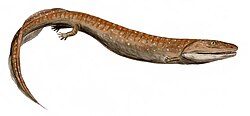| Heddleichthys | |
|---|---|
| Scientific classification | |
| Domain: | Eukaryota |
| Kingdom: | Animalia |
| Phylum: | Chordata |
| Clade: | Sarcopterygii |
| Clade: | Tetrapodomorpha |
| Clade: | Eotetrapodiformes |
| Family: | † Tristichopteridae |
| Genus: | † Heddleichthys Snitting, 2009 |
| Species: | †H. dalgleisiensis |
| Binomial name | |
| †Heddleichthys dalgleisiensis (Anderson, 1859) [1] | |
| Synonyms | |
| |
Heddleichthys is a genus of prehistoric sarcopterygian (lobe-finned "fish"), from the end of the Devonian period (Famennian). It was discovered in Dura Den Formation, Scotland. Heddleichthys is a derived tristichopterid, the first from Britain.





